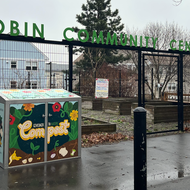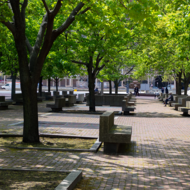New Urban Mechanics
We partner with departments and communities to explore, experiment, and evaluate new approaches to government and civic life.
The Mayor's Office of New Urban Mechanics (MONUM) was formed in 2010 as the Mayor's civic research and design team (one of the first in the nation). We explore and tackle intractable problems with fresh perspectives and lead experiments and prototypes that cover a range of topics.
OFFICE HOURS
Have a creative idea to improve the City? Let us know through email, or schedule a virtual brainstorm during an upcoming office hours on Tuesdays, from 2 - 4 p.m.
JOIN OUR TEAM
The 2026 Summer Fellowship application is now open. Applications will close on Tuesday, January 20th at 11:59 PM EST!
We are hosting an optional virtual open house for prospective applicants on Tuesday, January 6th, at 6pm (register here).
Highlights
Coordinated Furniture Pick-Up Pilot
We are testing whether coordinating furniture pick-up reduces the amount of furniture going to the landfill.
Public Space Invitational
Open call for people to experiment with temporary, delightful, interventions in the public realm.
Year in Review
Overview of our successes, challenges, and hopes each year.
Accessory Dwelling Unit
We want to streamline the process for homeowners looking to create a rental unit.
Our Projects
Common questions
QuestionsWhere do ideas for New Urban Mechanics projects come from?
All over! We are constantly keeping an ear out for interesting ideas to tackle. They come from:
- the Mayor (we are, after all, the Mayor’s Office of New Urban Mechanics!)
- Boston residents
- our colleagues in other departments
- Researchers
- other cities, and
- our own observations in the city and around the world ourselves.
From those ideas, how does New Urban Mechanics decide which projects to actually work on?
We’re generally looking for four roughly outlined criteria:
- Clear problem definition - are we working to solve a real problem?
- Feasibility - is it possible to try this idea in a near-term, small-scale way?
- Impact - does the idea seem like it could improve someone’s experience of the city?
- Scale and sustainability - will this idea have a life beyond the experiment? Can it move from pilot to program or policy? Does a department want to adopt it? “Scale” can mean a lot of different things, of course.
Can I or my organization work with New Urban Mechanics?
We’d love to find a way to collaborate! We are always excited to hear ideas that are people-centered and responsive to the moment we find ourselves in. You can sign up for upcoming office hours to chat with us about your ideas for improving civic experiences in Boston.
What are your impact measurements? Do you have innovation Key Performance Indicators (KPIs)?
While there isn’t always a standard set of metrics across projects, we try to have an idea of what success looks like when we start a new project. We may use a mix of approaches — quantitative and qualitative — to determine if our prototype has the impact we hope it will have. Generally, if we learn something that informs a future service or program the City can put in place, that’s a win. More broadly, we try to measure impact by hearing directly from people who interacted with the prototype and with quantitative measures that can show how the solution affected the problem we were targeting.
What is the governance model of the lab?
We sit in the Mayor’s office and report to the Mayor’s Chief of Staff. We have no specific content-focused mandate; instead, we have a broad mandate to work collaboratively across departments and topic areas. There is a Director and Deputy Director who guide and inspire the team, while also doing project work themselves.
Does New Urban Mechanics collaborate with startups? Universities?
Yes! See “Can I / my organization work with New Urban Mechanics?” above. Since 2010, we have been one of the “front doors” for startups and researchers who want to help Boston tackle some of its thorniest civic challenges. For example, we worked with Soofa while it was still a research lab out of MIT to field-test their solar-panel bench, which also charges devices via USB port. Additionally, our Autonomous Vehicle testing program, in partnership with the Transportation Department, worked with two local startups, nuTonomy and Optimus Ride. We founded a few research initiatives, such as the Boston Area Research Initiative and the Engagement Lab, in partnership with local academic institutions. We are delighted to see BARI live on at Northeastern
How does New Urban Mechanics work with the departments in the City?
- As you can probably guess, it depends project by project. If you asked some of our original partners, they’d probably tell you they think of us as an extra member of their team. With our newer collaborators, we can sometimes be their partners who ask hard (or basic) questions like, “What problem are we trying to solve?” “How do we know that is the solution? and “Who isn’t at the table for this conversation, but should be?” We can also connect them into our network of partners outside of City Hall. Sometimes we’re project managers, sometimes advisors, sometimes conveners, sometimes standing-out-on-the-street-asking-people-if-they-can-read-the-parking-sign (-ers), and always a little playful.
What are the sources of funding for New Urban Mechanics?
Our team is primarily funded out of the city’s operating budget and we supplement with funding from departmental partners and philanthropic funding, especially for special projects. Some of the philanthropies we’ve received funding from in the past include:
- Bloomberg Philanthropies
- Knight Foundation
- MacArthur Foundation
- National Safety Council
- Center on the Developing Child at Harvard University
- Ash Center for Democratic Government and Innovation
- Eos Foundation
- The Boston Foundation
- T.D. Bank, and
- Arbella Insurance Foundation, among others.
What elements are key to ensure the sustainability of a civic innovation lab?
Reinvention is a constant for innovation labs. We have to be responsive to current conditions in order to be effective partners and change agents. Close collaboration with our partner departments who will ultimately own the experiment is critical to demonstrating the value of a government innovation lab. Along the way, finding ways to nurture a culture of openness, creativity, and inclusion beyond our team is also important for longevity.
We aren’t just about doing innovative work ourselves, we want to support innovation across departments and led by our colleagues. We are also relied upon as a talent pipeline for other departments through our various fellowships and university partnerships. And to get down to brass tacks — so to speak — we have to deliver. We have to learn, explore, fail, talk about the work, and share the work as much as we can, so it’s clear how the City benefits from keeping us around.
What advice would you give to an emerging lab or a place thinking about starting a civic innovation lab?
- Be extremely intentional in your hiring processes.
- Come in with an open mind about where your projects and prototypes could go.
- Be pleasant (dare we say, fun?) to work with.
- Let your portfolio develop a mix of projects, a few of which are very experimental and may likely fail, many of which are likely to succeed but may be of limited impact, and shoot for some high-visibility, high-impact projects, too. It is important to have a steady pace of “products” that provides validity for the work, delivers for residents, and allows the government to learn in new ways.
- Show your work, structure it well, make it easy for others to track along or jump in.
- Get out in front of people, early and often.
- Find a healthy balance between skepticism and optimism.
What is human-centered design in a civic context, when city populations can be so diverse?
Simple: think about people first. Government is about helping people, not creating internal efficiencies, not cutting costs, not necessarily making things easier for internal staff (although often internal process improvements are necessary to better help people ). Aim to design with, not for. When you can, co-create with the people closest to the challenge. Get out of your office and go to where people actually are experiencing the City. Simple doesn’t necessarily mean easy.
Press
Here are some pieces that have been written or recorded about New Urban Mechanics and our way of working.
Podcasts
- Design is Everywhere (Design Museum Everywhere): Civic Design with Intention and Service at the Core
- Malmö Civic Lab (City of Malmö, Sweden): What's Boston Up To?
- Gimlet Creative (Wireframe): Good Design is Good Civics
- Mathematica (On The Evidence): Boston Invites Community to Set a Civic Research Agenda
- The Move Podcast S1E4: Designing for Delight
Articles
- Apolitical: Boston's innovation lab teaches government to take risks. Here's how
- Politico: Boston, There's an App for That
- Boston Globe: New Urban Mechanics, keep tinkering
- Fast Company: Boston Does Digital
- MIT Review: Cities Find Rewards in Cheap Technologies
- Governing: Will Urban Innovation Teams Outlast Political Change?
- GovTech: Boston Tackles Housing with Dedicated Innovation Lab



